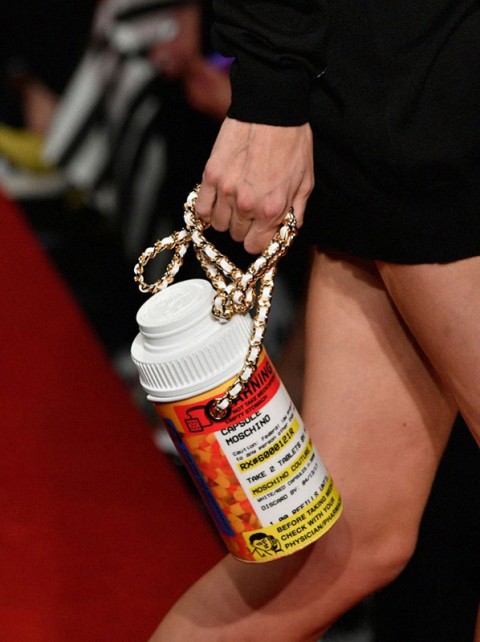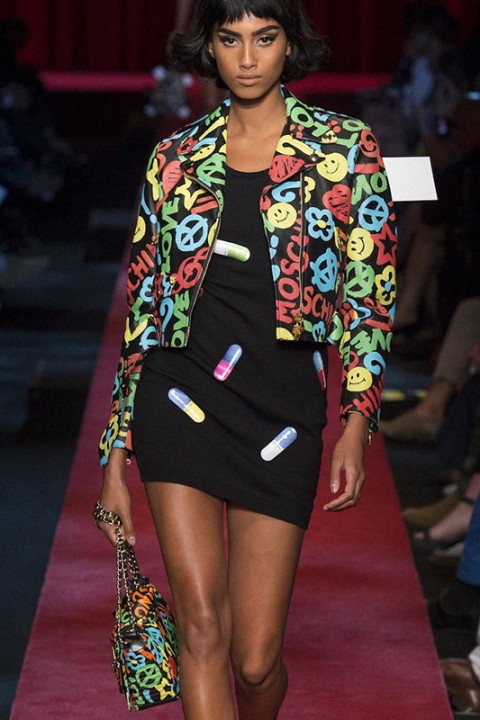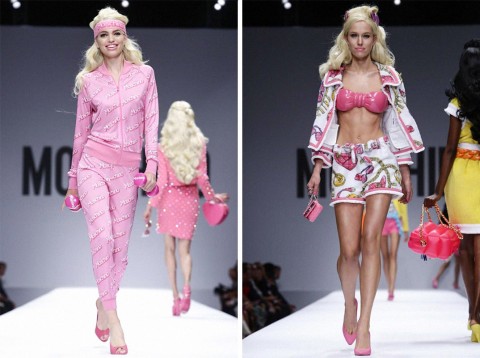Celebrities, Americana and pop culture with a twist of subversion: this is the winning formula which has come to characterize Jeremy Scott’s time as Moschino’s creative director. If critics say frequently that fashion takes itself too seriously, Scott looks to prove them wrong by reworking characters – including Spongebob, Barbie and, most famously, Ronald McDonald – for his tongue-in-cheek collections.
He’s also completely revolutionized the idea of “fast fashion” (get the McDonald’s reference?) by making collections immediately available online, as well as serving up compact capsule collections made up of teddy bears, branded dolls and, of course, phone cases which represent a (comparatively) cheap way to buy into Moschino’s seasonal vision.
Unsurprisingly, this approach has yielded enormous profits: last year, Moschino reported a 7 percent sales growth and, just a few months ago, Aeffe (Moschino’s owner company) revealed yet another increase in profits for the year of 2016. This indisputable commercial success has not, however, come without controversy.
His McDonald’s collection drew criticism from an employee of the fast-food chain for glamorizing and, they said, mocking minimum wage workers: “For people working in the highly-paid fashion world to think it’s ‘trendy’ to wear clothes inspired by the uniforms we put on every day to feed our kids, or to buy a designer bag that is a parody of the meals we serve to earn enough money just to pay our bills; well, it just makes me sad.”
Rex
Then there was his SS15 collection inspired by the ubiquitous Barbie doll, as well as its accompanying ad which aimed to bust gender stereotypes by featuring a boy playing with the doll – a move which was controversial but inarguably progressive.
His depiction of women, however, was arguably less positive: a SHOWStudio discussion panel discussed the questionable portrayal of women as Barbie dolls, branding it “offensive” and referring back to the body image debate which has plagued the history of Mattel’s famous cover girl.
SS17 once again saw Scott revisit the idea of the model as the doll, taking things a step further by showing dresses fitted with stiff paper tabs in reference to paper dolls and their customizable outfits. It’s not an original idea – John Galliano famously did it first in 2000, and fashion publications were quick to pick up the reference.

Getty
The real controversy came, however, with the revelation of a “capsule” collection themed around prescription drugs which was subsequently pulled from stores by US retailer Nordstrom.
Contextually, Scott has explained that his reference point was the ’60s cult classic Valley of the Dolls, a tale of three women in showbiz becoming slowly dependent on “dolls,” slang for prescription pills.
Beautiful protagonists, drugs and Hollywood unsurprisingly made for a winning combination: in 1974, the book was declared the fastest-selling ever up until that point and the film, although largely panned by critics, grossed more than $50 million worldwide. It may have been controversial, but the glamorization of drug addiction as self-destruction clearly struck a commercial chord and became a fascinating insight into the lascivious world of celebrity.

Getty
The film’s influence on Moschino’s SS17 collection is obvious: Scott references dolls both literally and in their slang form. Despite his explanations, the designer has been accused of promoting drug use – an American drug counsellor criticized both Scott and Nordstrom in an article published on FOX News: “I’m really disgusted that any retail store thinks this is OK, especially when our country is going through what the CDC has called a drug overdose epidemic.”
Moschino responded to the complaints by arguing that other pieces reworked the famous “Just say MoschiNO” anti-drug slogan for which the brand became famous.
The company claims that Scott’s intentions have been misunderstood, and that the “capsule collection” was merely a play on words. Still, it’s clear that an age of social media often proliferates images without context or explanation, making the backlash easy to predict.

But should fashion truly be forced to censor itself? After all, one of the most memorable fashion shows in history is Alexander McQueen’s 2001 “VOSS,” an exploration of fashion’s link to mental health issues set inside a glass asylum. Other designers to make political statements with their work include Vivienne Westwood, Jean Paul Gaultier and Hussein Chalayan, renowned for their respective explorations of activism, gender roles and war.
It’s also worth remembering that Scott is neither the first nor last designer to be accused of glamorizing drug use. The 1990s was dominated by the rave scene and its “acid house” offshoot which bled into the fashion industry, as well as the proliferation of the term “heroin chic” as synonymous with cool and desirable. Sisley’s famous “Fashion Junkie” incited huge controversy for its depiction of women taking drugs, whereas Franco Moschino, Jeremy Scott’s predecessor, used his fashion advertisements to make slogan-led statements on racism, consumerism and, of course, drug abuse.
Scott’s references to addiction should come as no surprise to those familiar with Moschino in the 1990s – if anything, his “capsule collection” is a simple case of picking up where Franco left off.

Getty
Still, it’s controversial and, from an ethical point of view, packaging a collection based on prescription pills and medication against the backdrop of a society increasingly plagued with mental health issues in a shiny commercial box seems to be exploitative at best, and dangerous at worst.
Many publications have, however, ignored his argument that this is a reworking of the famous “Just Say MoschiNO” slogan, and, in fairness, the “capsule” collection has to be considered in this context. It seems that this is less a case of deliberate offense and more a case of marketing without context.
Regardless of opinion, this latest controversy is merely another example of fashion’s turbulent relationship with addiction. On the one hand, it’s arguably positive for designers to tackle issues of abuse and drug dependence – it opens up the conversation, ignites debate and brings existing problems to the forefront. In this sense, Scott is simply continuing the work of his predecessor and upholding Moschino’s reputation as a brand willing to talk ideas, not just clothes.

Getty
On the other hand, the context of Moschino’s newfound commercial dominance has to be considered. This is fashion operating faster than ever before and, if Scott’s track record is to be believed, these clothes and accessories will sell in their droves.
They won’t necessarily be snapped up by consumers willing to consider their context or read around the collection to absorb the intended anti-drug stance; they’ll simply be picked up by consumers attracted to their bold design, primary color palette and controversial backstory. Ironically, history has proven that nothing boosts sales quite like a backlash.
Now check out these 10 contemporary artists you need to know.

